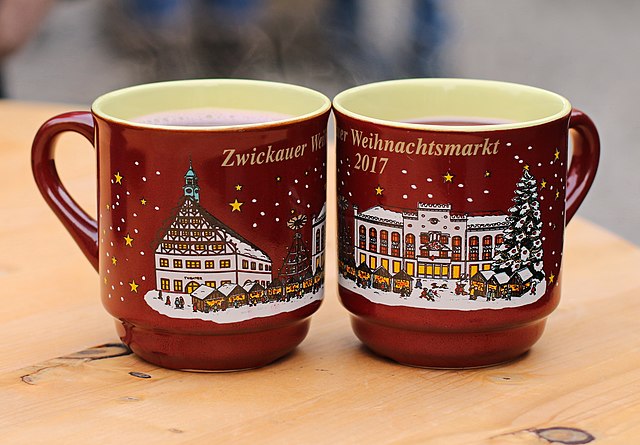If you’re European or British, it’s not a question of if you’re going to drink a hot mulled beverage at this season of the year. It’s a question of which hot mulled beverage, where, and with whom?
Steaming-hot mulled beverages define the season. They are usually made from spiced wines, juices, or ciders and appear just as Advent begins. Think of them like lights on the tree, glowing fireplaces, and gingerbread men in terms of seasonal importance.

In our stressed American culture where we live traffic-clogged car rides apart from everything, rather than a ten-minute walk to the town square, it’s hard to imagine how the tradition works. Basically, though, from Advent’s beginning until Epiphany, “the” thing to do several evenings a week is walk down to wherever people gather, maybe the corner eatery, and certainly the kiosks and tents set up at the Christmas markets, huddle by the outdoor fire or indoor heater, and spend the next two or three hours chatting, enjoying the Christmas lights, watching the kids run around (or ice skate, if the rinks are erected), while drinking something hot, tangy, and spicy.
Like so much that is good, the tradition of mulled wines and ciders goes all of the way back to . . . yes, you have it . . . the Ancient Greeks. It’s thought that the Greeks would dump spices into leftover wine, or any wine that had been judged substandard, and then heat it up. In an era when water could be toxic unto death, wine was the safest of all beverages. And no one likes to waste any part of the harvest.
According to one story, the Greeks called their spiced wine hippocras after the Father of Medicine, Hippocrates. More likely, his name was added later, as the drink continued to be regarded as health-bringing whenever cold weather arrived.
The Romans of course added their twist, and the name conditum paradoxum. This name for spiced wine with honey and pepper was, and still is, used in the Holy Land and appears in the Talmud. Rabbinical writings make mention of it too. A recipe from either the fifth or sixth century in Rome suggests one part wine to one part honey, boiled, reduced, and spiced. That would make one very sweet beverage!
The English term “mulled wine” shows up in 1618 but the potion had found its place earlier in British culture. A 1596 recipe by a man named Thomas Dawson reads:
Take a gallon of white wine, sugar two pounds, of cinnamon, ginger, long pepper, mace not bruised galingall [sic]…and cloves not bruised. You must bruise every kind of spice a little and put them in an earthen pot all day. And then cast them through your bags two times or more as you see cause. And so drink it.
The German style of Glühwein has gained ascendancy in recent years, partly because many American cities have established their own German-style Christmas Markets. I am thrilled at this development! In December 2007, flying from Dallas to Weimar, Germany for the Christmas holidays with our daughter and our Korean exchange student Ga Hee, we planned an 8-hour layover in Chicago so we could show the girls a bit of Chicago skyline. Popping out of the metro at Washington Station, we stood right in the middle of Chicago’s Christmas Market in Daley Plaza. It was freezing cold, of course. As for the market itself: wow! For just a minute, I thought: “Did I sleep through the whole flight and we’re somehow in Germany?” And yes, the smell of the Glühwein drifted through the air in Chicago just as it does in Nuremberg or Dresden.
Beyond the drink itself, the special cups and mugs that go with it really matter. Towns in Europe design a new ceramic or glass mug every year for their Christmas Markets, marking it with the date to insure it will be a local collector’s item. Some are tall and skinny, some are hefty, some are graceful and elegant, and some have interesting shapes and handles. As the European Christmas Markets are being shut down one-by-one right now, perhaps the fact that the mugs for 2021 were made, shipped, and available can serve as a small consolation for vendors otherwise losing their annual income. Even with these markets per se closed, kiosks and cafes will still be offering Glühwein and other seasonal treats for folks to enjoy.
The best thing to do with mulled wine, though, is to use it as a hand warmer and nose delighter while enjoying your company of friends. Cold friends, too, for you have to be cold, or coming in from the cold, to enjoy its full effects. For that matter, people who touch nary a drop of fermented anything all year find themselves welcoming a bit of mulled beverage at Christmastime, especially when they are spending hours at outside events.
So, whether you use one of the dozens of online recipes (go ahead, try a medieval or Ancient recipe), create your own blend, or buy the pre-packaged mixes (some bagged like teabags), it really is Glühwein season. Find the pepper, honey, saffron, bay leaves, cinnamon, cloves, and whatever else is floating around your cabinet, get some apple cider, grape juice, or basic wine and a big saucepan or slow cooker. Toss it all in, wait till its fragrance blossoms throughout your house. Then grab some of your nicest or most interesting cups and mugs, as well as favorite friends and family. Invite the dog, too, just because everything is better when a doggie wanders in and out of the party. See if you don’t feel as if you are suddenly part of A Christmas Carol (yes mulled wine is mentioned there). Good cheer, good cheer!



